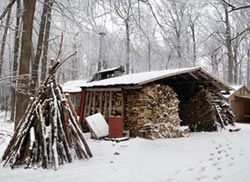Drip, drip … slowly a bucket fills with the beginning of sweet memories. After those long dark winter days, that soft sound is a welcome reminder that spring is soon arriving. The maple-sugaring season's start, length, and end are dictated by the weather. In Indiana, the season usually occurs between February and April.
To get that golden maple syrup on your morning pancakes, you first need a sugar maple tree. Others trees can be used, but the sugar maple has the highest amount of sugar in its sap. Once you find your stand of trees (sometimes called a sugarbush), wait until the daytime temperatures reach about 40 F. An enzyme in the tree that converts starches into sugars is only active at that temperature. Once converted, the sugars then pass into the sap. The rising temperatures cause pressure inside the trees to build which in turn causes the sap to flow. When a hole is drilled into the tree, the sap begins to leak out.
This is where tapping comes in. To collect the sap, a metal tube is gently tapped into the drilled hole. This directs the sap directly into the bucket or plastic tubing - a more modern way of collecting sap. One tap hole can produce anywhere from five to fifteen gallons of sap. This may seem like a lot, but it takes 10 gallons of sap to make just one quart of syrup!

Yoder's Sugarbush: A hands-on,
maple syrup-making experience
Once the sap is collected and has been strained, it is time to boil. This is a long process because the boiling sap must be watched to prevent it from boiling over or burning. Also, it is a good project for outside or for a vented "sugar shack," because sap is mostly water and the large quantity of steam produced in the reduction process can take the wallpaper off the walls! Once it reaches desired density, the syrup is filtered for removal of sediments and then bottled---or poured over a stack of pancakes! Sometimes the syrup is boiled further down to get maple sugar.
Maple syrup production stops when the temperatures reach about 45 F because the enzyme stops converting sugars. This is also when the leaf buds start to break open and experienced syrup producers say this causes the syrup to become bitter. Although maple sugaring may happen once a year, the sweet taste of maple syrup and sugar can be enjoyed year-round.
